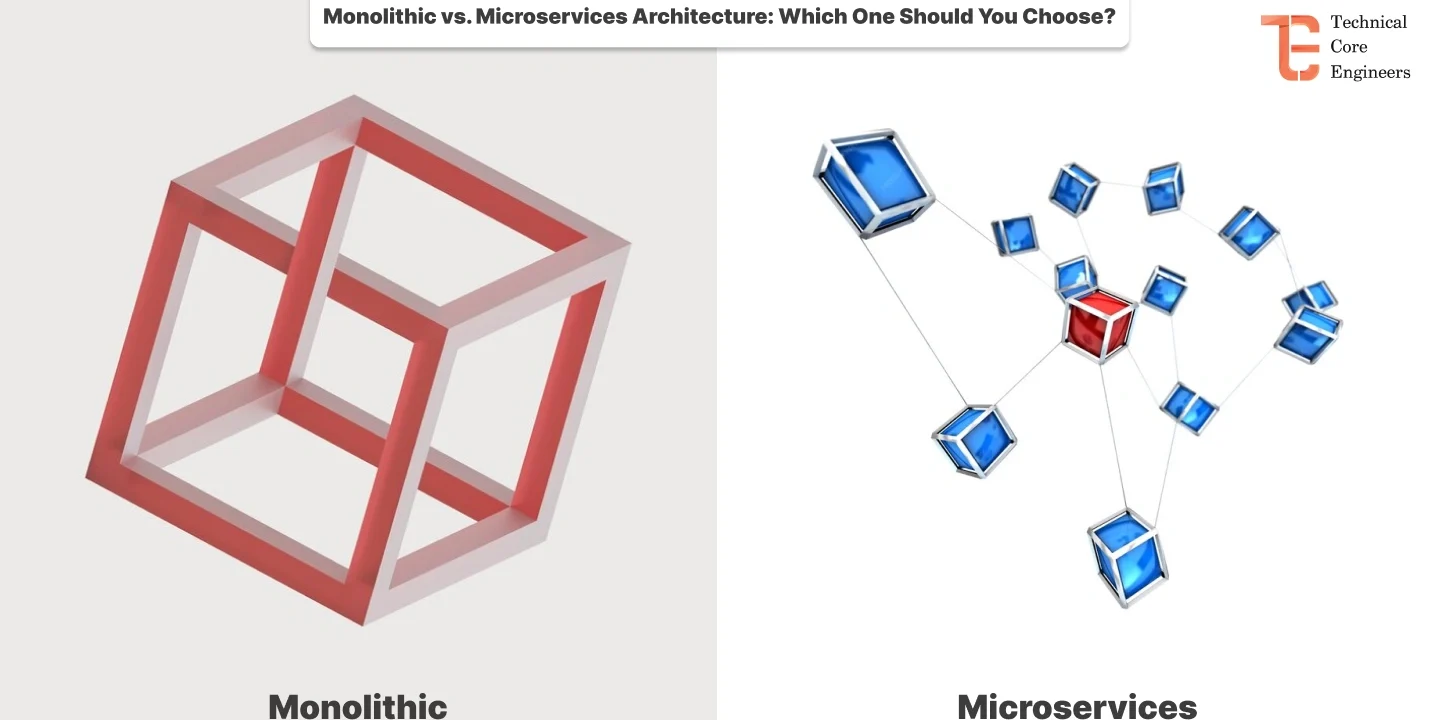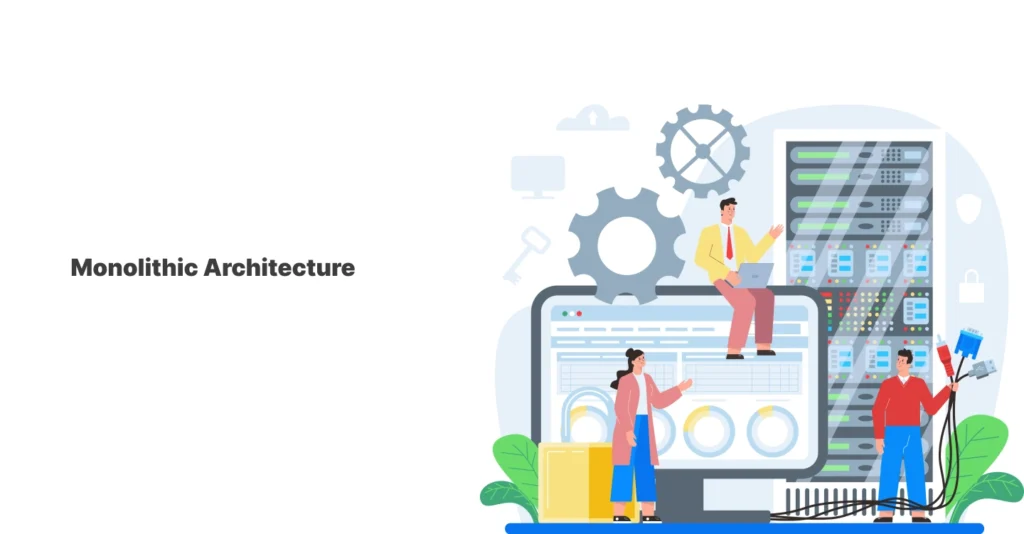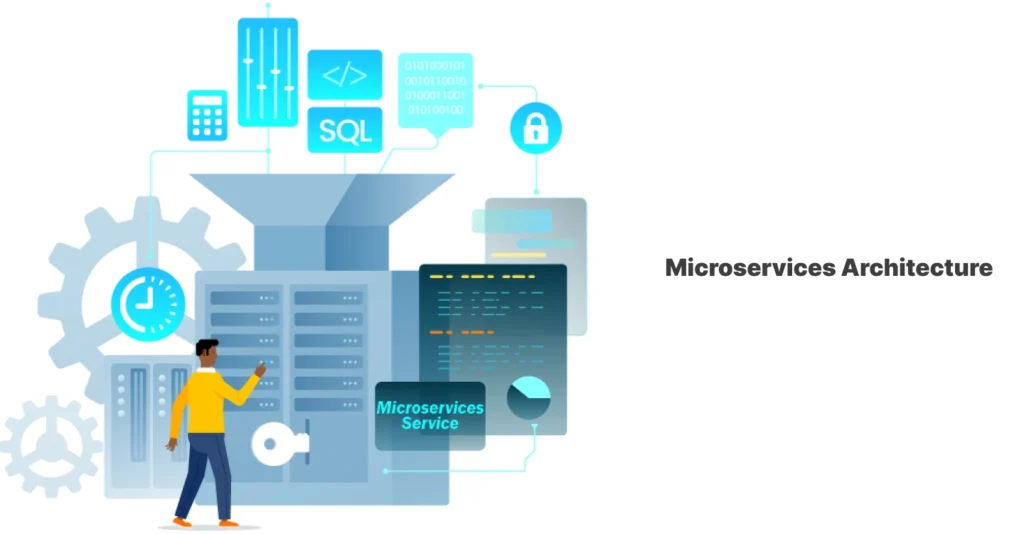- Home
- Web Development
- Monolithic vs. Microservices A ...

In today’s software development landscape, choosing the right architectural pattern for your application is crucial for its long-term success. Two of the most prominent architectural styles are monolithic and microservices architectures. Each has its own set of advantages and trade-offs that need to be carefully considered before making a decision.
Understanding Monolithic Architecture

A monolithic architecture is the traditional unified model for software design. Think of it as a single, self-contained application where all functionality exists in one codebase. Like a massive skyscraper housing all departments of a company, everything is interconnected within one structure.
In a monolithic architecture, components are tightly coupled within a single application. For example, an e-commerce platform built as a monolith would have its product catalog, shopping cart, payment processing, user management, and notification systems all packaged together in a single deployable unit. Changes to any part of the system require rebuilding and redeploying the entire application.
Typically, monolithic applications consist of:
- A single codebase that all developers work on
- A shared database that stores all application data
- A single build and deployment pipeline
- Unified logging, monitoring, and error handling
Advantages of Monolithic Architecture
The monolithic approach offers several compelling benefits:
Simplified Development Process
Development is straightforward as there’s only one codebase to work with. Teams can use consistent tools and frameworks across the entire application, making the development process more uniform and manageable. Developers can also leverage IDE features more effectively with a unified codebase, enhancing productivity through better code navigation, refactoring tools, and compilation checks.
Easier Debugging and Testing
With all code in one place, developers can follow execution paths more easily and conduct end-to-end testing more efficiently. There’s no need to simulate service calls or handle distributed system complexities. Stack traces are continuous and comprehensible, making bug identification faster. Integrated testing is also simpler, as you can create tests that cover multiple features within the same process.
Streamlined Deployment
Deployment is simpler since there’s only one application to deploy. This means fewer complications with coordinating multiple services and their dependencies. Deployment can be as straightforward as uploading a WAR file to an application server or deploying a single container. The deployment process requires less orchestration and has fewer points of failure.
Simplified Transaction Management
In a monolithic application, managing transactions across different parts of the system is much simpler. Since everything runs in the same process, ACID (Atomicity, Consistency, Isolation, Durability) transactions can be used to maintain data integrity without the complexities of distributed transactions.
Reduced Cross-Cutting Concerns Complexity
Security, logging, caching, and other cross-cutting concerns are easier to implement consistently across a monolithic application. You can apply aspects or middlewares that affect the entire application without coordinating across multiple services.
Challenges of Monolithic Architecture
However, monolithic architectures come with their own set of challenges:
Scaling Limitations When different components have varying resource requirements, you must scale the entire application rather than just the components that need it. This can lead to inefficient resource utilization. For instance, if your product catalog requires more processing power during a sales event, you would need to scale the entire application, including components like user authentication that might not need additional resources.
Technology Lock-in Once you’ve chosen your technology stack, it’s challenging to adopt new technologies without potentially rewriting the entire application. If your monolith is built with Java and Spring, adopting a new JavaScript framework or Rust for performance-critical components becomes extremely difficult. This can prevent teams from leveraging new technologies that might better solve specific problems.
Maintenance Complexity As the application grows, the codebase becomes larger and more complex, making it harder to understand and maintain. Changes in one part of the application can have unexpected effects on other parts. Developers new to the project face a steep learning curve to become productive. The “big ball of mud” anti-pattern often emerges, where clear boundaries between components dissolve over time.
Deployment Risk Every change, no matter how small, requires redeploying the entire application. This increases the risk of each deployment and can lead to longer deployment processes as the application grows. A minor bug fix for one feature could potentially affect unrelated parts of the system.
Development Team Bottlenecks As the application and team grow, coordinating work on a single codebase becomes challenging. Merge conflicts become more frequent, build times get longer, and development velocity decreases. Teams may step on each other’s toes when working on different features that touch the same parts of the code.
Limited Continuous Deployment The all-or-nothing nature of monolithic deployments makes continuous deployment more challenging. Even if only one small component changes, the entire application must be tested and deployed, making it difficult to release changes frequently and safely.
Understanding Microservices Architecture

Microservices architecture breaks down an application into smaller, independent services that communicate through well-defined APIs. It’s like a business park where different companies operate independently but work together when needed.
In a microservices architecture, each service:
- Is responsible for a specific business capability or domain
- Has its own dedicated database or data storage
- Can be developed, deployed, and scaled independently
- Communicates with other services through network calls
- Is owned by a specific team that is responsible for its lifecycle
For example, an e-commerce platform built with microservices might have separate services for product catalog, inventory management, shopping cart, user profiles, payment processing, and order fulfillment. Each service would have its own codebase, database, and deployment pipeline.
Advantages of Microservices Architecture
The microservices approach offers significant benefits in certain scenarios:
Independent Scaling Each service can be scaled independently based on its specific requirements. This leads to more efficient resource utilization and better cost management. For example, during a flash sale, you can scale up only the product catalog and order processing services without increasing resources for less-used features like user profile management. This granular scalability is particularly valuable in cloud environments where you pay for the resources you use.
Technology Flexibility Teams can choose the best technology stack for each service. This freedom allows for optimization of each component and easier adoption of new technologies. A computationally intensive service might be built using Go or Rust for performance, while a content management service might leverage Node.js and Express for rapid development. This flexibility extends to databases as well – you can use SQL databases for transactional data and NoSQL solutions for services that need schema flexibility.
Improved Fault Isolation Issues in one service are less likely to affect others, making the system more resilient. Services can be updated or replaced without impacting the entire application. If the recommendation engine fails, customers can still browse, add items to their cart, and complete purchases. This isolation reduces the blast radius of failures and makes the system more robust overall.
Team Autonomy and Specialized Expertise Teams can work independently on their services with minimal coordination. This autonomy allows teams to develop specialized expertise in their domain and technology stack, leading to better solutions and increased productivity. The “two-pizza team” model (teams small enough to be fed with two pizzas) works well with microservices, where each team owns a small set of related services.
Faster Development Cycles Smaller codebases, independent deployments, and clear service boundaries enable faster development and deployment cycles. New features can be shipped more quickly as they don’t need to be coordinated with unrelated changes in other parts of the system. This agility allows organizations to respond more quickly to market demands and user feedback.
Easier Onboarding and Knowledge Management New developers can become productive more quickly because they only need to understand the specific services they’re working on, not the entire system. Documentation, codebases, and domain knowledge can be managed more effectively when divided into smaller, focused services.
Better Support for Continuous Deployment Independent services can be deployed continuously without affecting other parts of the system. This enables organizations to adopt DevOps practices more effectively and maintain a rapid, consistent release cadence.
Challenges of Microservices Architecture
Microservices architecture also presents its own challenges:
Increased Operational Complexity Managing multiple services requires sophisticated deployment pipelines, monitoring systems, and inter-service communication handling. Organizations need to invest in robust DevOps practices, including containerization (Docker), orchestration (Kubernetes), service discovery, centralized logging, distributed tracing, and monitoring. The operational overhead is significantly higher than with monolithic architectures.
Distributed System Challenges Teams must deal with network latency, data consistency, and other distributed system complexities that don’t exist in monolithic applications. These include:
- Network failures and timeouts
- Eventual consistency across services
- Distributed transaction management
- Asynchronous communication patterns
- Service discovery and load balancing
- Version compatibility between services
Understanding and addressing these challenges requires expertise in distributed systems design patterns like Circuit Breaker, Bulkhead, and Saga patterns.
Higher Initial Investment Setting up the infrastructure and tooling required for effective microservices development and deployment requires significant upfront investment. This includes:
- CI/CD pipelines for multiple services
- Service mesh implementation (like Istio or Linkerd)
- API gateway configuration
- Monitoring and observability tools
- Centralized logging and tracing infrastructure
- Container orchestration platforms
For small teams or startups with limited resources, this initial overhead can be prohibitive.
Data Management Challenges Maintaining data consistency across multiple services with independent databases is challenging. You must decide between eventual consistency or implement complex distributed transaction mechanisms. Domain boundaries must be carefully designed to minimize cross-service transactions. Additionally, data duplication across services is often necessary, requiring mechanisms to keep this data in sync.
Testing Complexity Testing becomes more complex with microservices. While unit testing individual services might be simpler, integration testing across services requires sophisticated approaches:
- Service virtualization or contract testing
- End-to-end testing in staging environments
- Chaos engineering to test resilience
- Performance testing distributed transactions
- Testing version compatibility between services
Communication Overhead Microservices introduce network communication between components that would be in-process method calls in a monolith. This adds latency, requires error handling for network failures, and increases the overall complexity of the system. API design becomes crucial to minimize unnecessary communications.
Debugging Complexity Tracing issues across service boundaries is more difficult. A single user request might touch dozens of services, making it challenging to follow the execution path. Distributed tracing tools like Jaeger or Zipkin become essential but add another layer of infrastructure to maintain.
Making the Right Choice
The decision between monolithic and microservices architecture should be based on several key factors:
Choose Monolithic When:
- Your application is relatively small and simple: For applications with limited functionality or clear boundaries, the complexity of microservices might outweigh the benefits. A startup MVP or internal tool with a well-defined scope is often better suited to a monolithic approach.
- Your team is small or new to distributed systems: Microservices require expertise in distributed systems, DevOps practices, and domain-driven design. If your team lacks this expertise, starting with a monolith allows you to focus on delivering business value while building these skills gradually.
- Time-to-market is a critical factor: For new products where validating market fit quickly is essential, a monolith can get you to market faster with less infrastructure overhead. You can always refactor toward microservices once you’ve validated your product.
- You’re building a proof of concept: When exploring a new idea or market, the speed and simplicity of a monolithic approach allow for faster iteration and validation before investing in a more complex architecture.
- Your application has simple scaling requirements: If your application doesn’t face significant variations in load across different components or can scale horizontally without issue, a monolith might provide adequate scalability with less complexity.
- Operational resources are limited: If you don’t have dedicated DevOps personnel or the budget for extensive cloud infrastructure, the operational simplicity of a monolith is a significant advantage.
Choose Microservices When:
- Your application is complex with distinct business domains: Large applications with clear domain boundaries and different business capabilities are good candidates for microservices. E-commerce platforms, content management systems with multiple modules, or enterprise applications with diverse functionality fit this pattern well.
- You have multiple teams working on different components: When multiple teams need to work independently on different parts of the application, microservices provide the necessary autonomy and clear ownership boundaries.
- You need independent scaling for different components: If some parts of your application experience significantly higher load than others, or have different resource requirements, the ability to scale components independently can provide substantial cost savings and performance benefits.
- You’re building a long-term platform that needs technology flexibility: For platforms expected to evolve over many years, microservices provide the flexibility to adopt new technologies and approaches without rewriting the entire system. This future-proofing can be valuable for long-lived applications.
- Your organization has the expertise to handle distributed systems: Microservices are most successful when your team has experience with API design, distributed systems patterns, DevOps practices, and domain-driven design. Without this expertise, the challenges may outweigh the benefits.
- You have high availability requirements: When different parts of your system need different levels of availability, microservices allow you to design and scale each component accordingly. Critical services can have redundancy and failover mechanisms while less critical ones can have simpler architectures.




